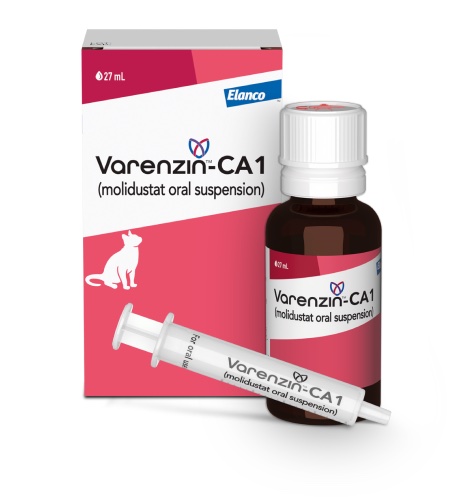 Listen to this story.
Listen to this story.
Varenzin

Elanco Animal Health photo
A syringe used by pet owners to administer a drug for treating anemia in cats with chronic kidney disease could become unreadable, raising a danger of misdosing, according to an alert sent to veterinarians by the pharmaceutical company Elanco Animal Health.
The drug, Varenzin (molidustat), is a new product that launched in September. An oral suspension, it's typically given at home through a syringe that delivers the medication into the cat's mouth.
In its letter to veterinarians, dated March 28, Elanco said the scale on the outside of the syringe can become unreadable if it comes in contact with the medicine. "This situation can occur during administration if the syringe is not firmly inserted into the bottle when drawing out the medication, which can result in leakage down the outside of the syringe," the letter states.
Asked for elaboration, the company said via a spokesperson: "Because the medication is based in a flavorful sunflower and fish oil base, these oils can remove the ink on the outside of the syringe after several exposures."
Elanco told veterinarians that it is "exploring options for a long-term solution," which it confirmed involves procuring syringes that aren't vulnerable to the problem. In the meantime, the company said veterinarians should direct cat owners to carefully follow the dosing directions on the product label, especially noting to "place the syringe nozzle firmly into the opening of the bottle" so product doesn't leak out.
The U.S. Food and Drug Administration granted conditional approval to Varenzin in May 2023, and the product became commercially available in September.
Varenzin is the first FDA-approved drug that controls nonregenerative anemia associated with chronic kidney disease in cats. Nonregenerative anemia, which can be fatal, is characterized by a failure of the patient's bone marrow to produce sufficient red blood cells, resulting in an inability of the blood to carry adequate amounts of oxygen from the lungs to the rest of the body.
Anemia is a frequent complication of chronic kidney disease, which commonly affects older cats.
Elanco told the VIN News Service that the Varenzin syringe issue has occurred in "just a handful of cases," but it issued the warning letter swiftly to limit further incidents.
For those who have experienced problems with their syringes, Elanco says it will provide free replacements. Alternatively, if a replacement is needed urgently, the company advises veterinarians to consider supplying clients with a 1-mL or 3-mL luer slip tip syringe — provided it fits securely into the adaptor tip of the bottle and can accurately measure in 0.1-mL increments.
Dr. Susan Klein, a specialist in small animal internal medicine, who also is a consultant for the Veterinary Information Network, an online community for the profession and parent of VIN News, notes that Varenzin comes with an illustrated four-step instruction guide.
The bottle, the instructions indicate, should be turned upside down for the syringe to draw out the correct dose but must be turned right-side up before the syringe is removed and the bottle recapped. Klein wonders if some pet owners could be withdrawing the syringe before turning the bottle right-side up.
"One take-home message is that we — veterinarians and support staff — would want to be sure that we understand the directions for use," she said in an interview by email. "And we would want to be sure that we are educating our clients so that they understand how to administer the medication properly."
In the product insert, Elanco recommends that owners wash their hands after medicating the cat. The insert also says women who are pregnant or may become pregnant should administer the product with caution.
Although Elanco states that nobody should "disassemble or wash the syringe," both the company and Klein suggest that pet owners could gently wipe the syringe with a tissue if the product appears to have seeped out, being careful not to rub off the measurement markings.
"They could use a dry tissue, but it is not known if wiping the syringe down would have a positive or negative effect on the visibility of the ink on the syringe," Elanco told VIN News. It added that cat owners should contact their veterinarian right away if the markings on the syringe become difficult to read.
If cats were to receive a chronic underdose of Varenzin, the drug may not work as well or at all.
As for the consequence of chronic or acute overdosing, Elanco and Klein concur that too much drug potentially could result in polycythemia, an overabundance of red blood cells that reduces blood flow and promotes clotting.